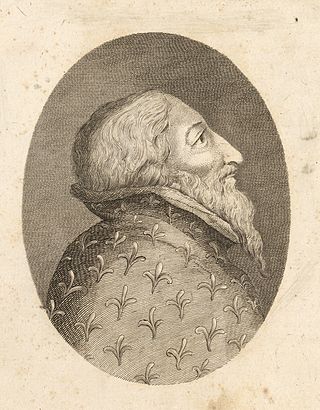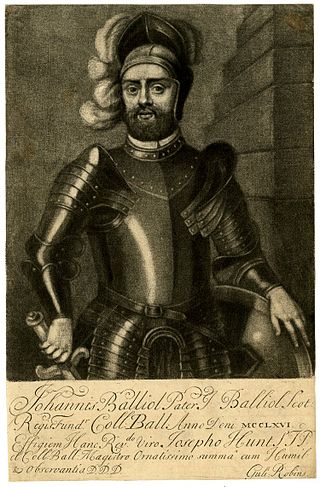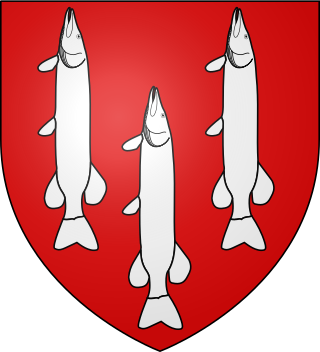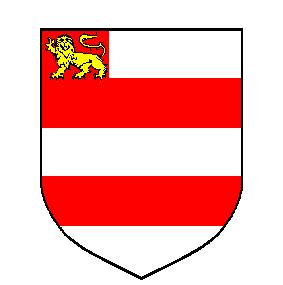
Henry Percy, 1st Earl of Northumberland, 4th Baron Percy, titular King of Mann, KG, Lord Marshal was the son of Henry de Percy, 3rd Baron Percy, and a descendant of Henry III of England. His mother was Mary of Lancaster, daughter of Henry, 3rd Earl of Lancaster, son of Edmund, Earl of Leicester and Lancaster, who was the son of Henry III.

Baron Dacre is a title that has been created three times in the Peerage of England, each time by writ.

John de Balliol was an English nobleman, belonging to the House of Balliol. Balliol College, in Oxford, is named after him.

Egremont is a market town, civil parish and two electoral wards in Cumbria, England, and historically part of Cumberland. It is situated just outside the Lake District National Park, five miles south of Whitehaven and on the River Ehen.

The title Baron Multon de/of Egremont was created once in the Peerage of England. On 6 February 1299 Thomas de Multon was summoned to Parliament. On the death of the second baron, the barony fell into abeyance in 1334.

Ralph Dacre, 1st Baron Dacre was an English peer.

Eva Marshal (1203–1246) was an Anglo-Norman noblewoman, daughter of William Marshal and Isabel de Clare, the Earl and Countess of Pembroke. She married William de Braose, a marcher lord.
Sir Thomas Moulton, Moleton, Muleton, or Multon, also recorded as Thomas de Moulton, Thomas of Moulton, etc., was an English landowner, knight, and judge during the reigns of King John and King Henry III. From a family with landholdings in the south of Lincolnshire, he was the son and heir of Thomas Moulton and his wife Eleanor Boston. After initial military service, he became a senior judge and held important government positions, in the process extending his inherited estates and accumulating considerable wealth.

de Lucy or de Luci is the surname of an old Norman noble family originating from Lucé in Normandy, one of the great baronial Anglo-Norman families which became rooted in England after the Norman conquest. The first records are about Adrian de Luci who went into England after William the Conqueror. The rise of this family might have been due to Henry I of England, although there are no historical proofs that all de Lucys belonged to the same family.

Anthony de Lucy, 1st Baron Lucy was an English nobleman who served as warden of Carlisle Castle and Chief Justiciar of Ireland.
Lord Thomas de Moulton was the first Baron Multon of Gilsland.

Thomas de Multon, Lord of Egremont, was an English noble.

Richard Óg de Burgh, 2nd Earl of Ulster and 3rd Baron of Connaught, called The Red Earl, was one of the most powerful Irish nobles of the late 13th and early 14th centuries and father of Elizabeth, wife of King Robert the Bruce of Scotland.

John Harington, 1st Baron Harington (1281–1347) of Aldingham in Furness, Lancashire, was an English peer, created Baron Harington by writ of summons to Parliament dated 1326.

John Harington, 2nd Baron Harington (1328–1363) of Aldingham in Furness, Cumbria, was an English peer, who inherited the title Baron Harington in 1347 on the death of his grandfather John Harington, 1st Baron Harington (1281–1347).

Gilbert fitz Roger fitz Reinfried, or Gilbert the son of Roger fitzReinfrid, was an Anglo-Norman feudal baron whose administrative career in England began in the time of Henry II (1154-1189), for whom his father Roger fitzReinfrid had been steward, and continued during the reigns of Richard I, King John, and Henry III.
Hugh de Morville Baron of Burgh, Lord of Kirkoswald, was an English noble.

Richard de Luci, sometimes spelt Lucy, Baron of Egremont and Copeland, was an English noble.
Thomas II de Multon, Moulton, or Muleton, Baron of Burgh and Gilsland, was an English noble.
Alan de Multon, Lord of Papcastle, who held lands in Cockermouth, was an English noble.











